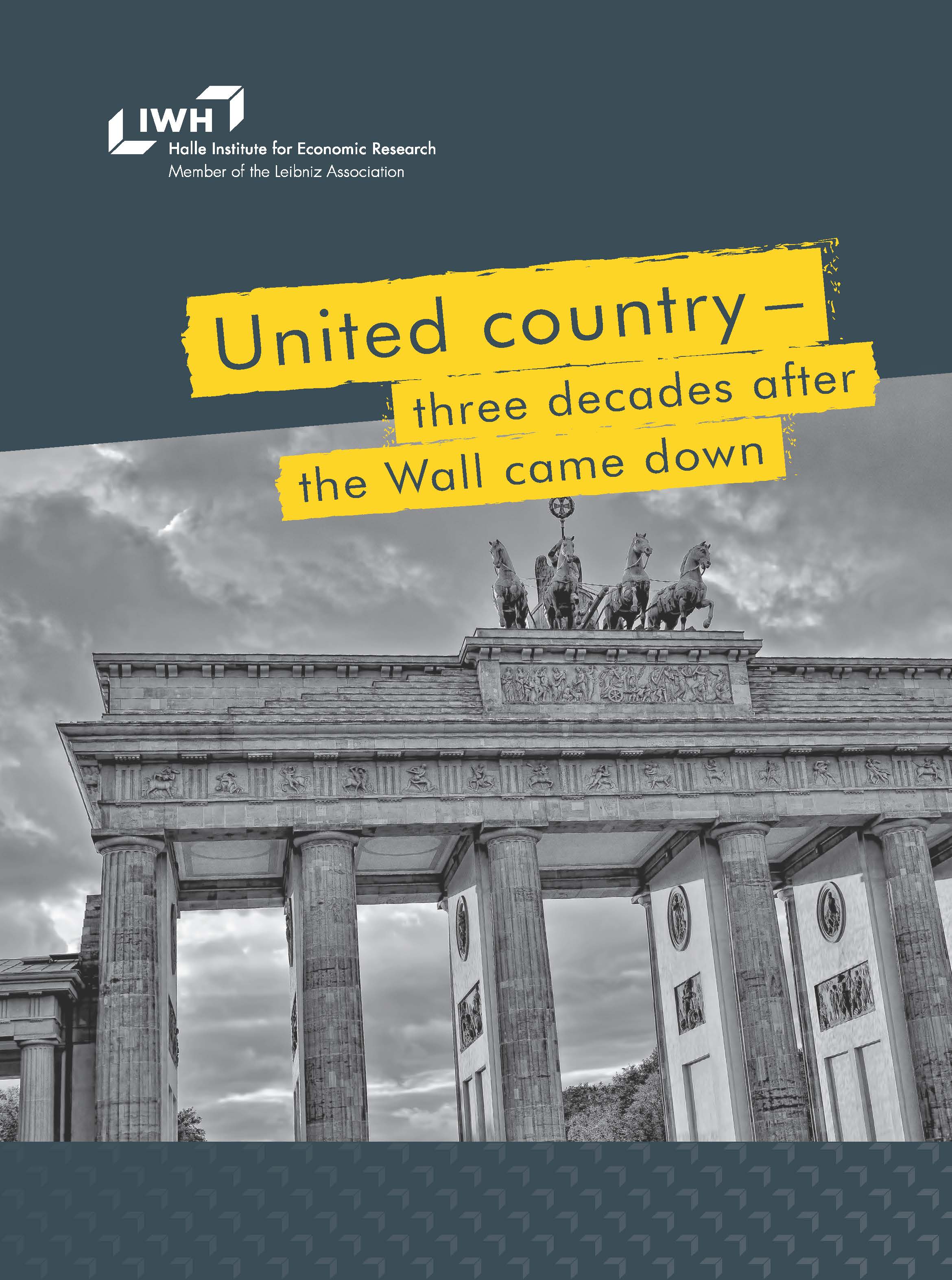New IWH publication takes stock: “United country – three decades after the Wall came down”
In principle, Germany overall shows considerable economic progress since the Wall came down. However, there are still considerable differences between the country’s regions. Be it economic output, income, immigration or education: frequently, the regional trends continue to reflect the former border between East and West Germany. This is shown in 35 maps and graphs in a publication presented by the Halle Institute for Economic Research (IWH) in Berlin today. “United country – three decades after the Wall came down” is a detailed analysis of the state of unification by IWH on the anniversary of the fall of the Berlin Wall. The key findings are:
1) The economy in East Germany is less productive than in the west– and not only due to a lack of corporate headquarters. 464 of Germany’s 500 largest firms are based in the west of the Republic, which corresponds to around 93%. As productivity generally increases in line with company size, productivity is lower in East Germany. However, this is only part of the story. Comparable firms of the same size in East Germany are about 20% less productive than their counterparts in the west. According to IWH economists, the fact that the potential for productivity gains in East Germany is not yet being fully exploited is also due to government subsidies: because subsidies are paid conditional on maintaining jobs, this may have reduced labour productivity. While this may have made sense at times of high unemployment, in times of skilled labour shortages, this policy should be rapidly abandoned.
This publication helps our understanding of the regional differences in today’s Germany
2) Strengthening cities advances the entire country. Productivity differs more between eastern and western German cities than between rural regions. The reasons for this: corporate headquarters are often located in (western German) cities and three quarters of employees in the west work in cities, while only half do so in the east. If, however, there is to be convergence between economic power in the east and west, then the cities must be strengthened in particular. Because this is where the high-quality services that are increasingly defining the economy are created. In a knowledge-based society, cities are the centres of research, innovation and value creation – and therefore prosperity.
3) More progress requires sufficient skilled labour. East Germany no longer has a general deficit in physical capital. But it does have a growing shortage of skilled labour. There are four reasons for this. (1) Until the early 2000s, the east had a larger proportion of highly skilled workers than the west; this advantage has now been lost almost everywhere. (2) School drop-out rates are higher than in West Germany. (3) In future, the number of people of working age will decline much faster in eastern German states than in western German states. (4) Highly skilled immigrants, such as those who hold an EU Blue Card, are more likely to move to western than to eastern German regions. Only Berlin attracts an above average number of these immigrants.
We also want to send a message to politicians: if they tackle the structural issues in Germany as a whole, then the east will also make good progress.
This is where politics comes in: excellent conditions attract excellent staff. Places with attractive living and working conditions and a wide range of scientific, educational and cultural institutions can promote structural transformation in East Germany if they present themselves as being open and attractive for skilled immigration.
The publication draws on expertise from more than 25 years of research, during which IWH has examined developments in East Germany, among other things. “This publication helps our understanding of the regional differences in today’s Germany,” says IWH President, Reint Gropp. “We also want to send a message to politicians: if they tackle the structural issues in Germany as a whole, then the east will also make good progress. We should recognise services as a major growth driver. We should invest in education and science, thereby increasing productivity potential. And we should turn our cities into places of innovation that attract skilled immigration.”
Publication
Halle Institute for Economic Research (IWH) – Member of the Leibniz Association (ed.): United country – three decades after the Wall came down. 152 pages, bilingual (German/English), illustrated section with 35 colour maps and graphs. Halle (Saale) 2019.
Whom to contact
For Researchers

Senior Economist
If you have any further questions please contact me.
+49 345 7753-753 Request per E-MailFor Journalists

Internal and External Communications
If you have any further questions please contact me.
+49 345 7753-832 Request per E-MailIWH list of experts
The IWH list of experts provides an overview of IWH research topics and the researchers and scientists in these areas. The relevant experts for the topics listed there can be reached for questions as usual through the IWH Press Office.
Related Publications

United Country – Three Decades After the Wall Came Down
in: One-off Publications, 2019
Abstract
Die Berliner Mauer als das Symbol der deutschen Teilung ist mittlerweile länger verschwunden als sie gestanden hat, doch die Unterschiede innerhalb des Landes sind auch nach drei Jahrzehnten noch sichtbar. Jüngste Forschungsergebnisse zeigen jedoch, dass die Bruchkante der wirtschaftlichen Entwicklung nicht immer ausschließlich entlang der ehemaligen innerdeutschen Grenze verläuft, sondern neben dem West-Ost-Gefälle auch Süd-Nord- oder Stadt-Land-Unterschiede zutage treten.




